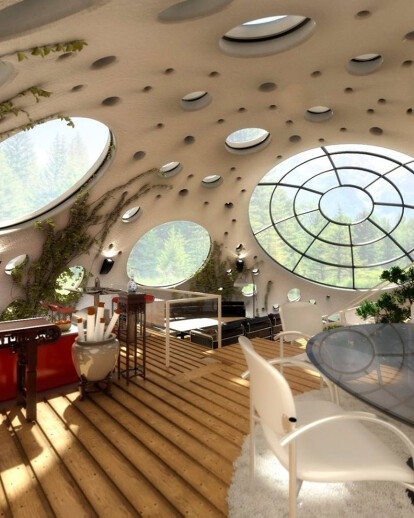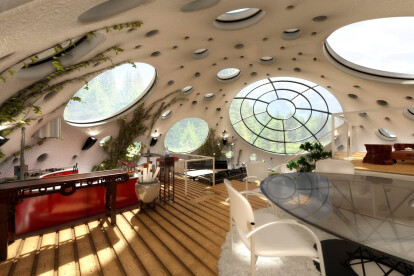Solar House: It is all about light The project main idea lay on the sun interaction with a domo located in New Scotland, Canada. The first step was to find out how the building reacts to sun light in different day key moments all along the year. The use of a 3d software allows me to figure out which areas would be exposed to sun light and which ones would be into shadow. At that point, I found an area that would be always exposed to light. Due to Canada cold weather, we need to optimize natural light. The building has a great window in the always exposed to sun area to make sure the house would have natural light inside every day at any time. The second step it was to find how was a daily life in Canada, the standard time timetable. From that find which activities do need direct illumination and which ones do need not direct illumination. I found what would be the sun impact on the house by the time those activities take place, which part on the house would be on shadow and which one would be directed exposed to sun, so I could do a distribution of the house with certainty that each activity would have proper illumination. Steps: 1_To analyze daily life in Canada: at what time each activity take place
2_To classify different activities: one group with the ones that requires direct illumination, another one with the indirect illumination activities.
3_From the previous analysis, I see the sun position in relation to the Woodenigloo by the time the activity takes place
4_Acording to the sun position and the kind of illumination each activity needs, I do an internal distribution in which each area will be directly related to the light. Swarm concept, I propose a great open space with multiple platforms at different levels creating an internal landscape. Those platforms are organized by sun incidence but also by the function they will contain. The passive activities, such as sleeping, studding or reading, are in the ground levels. The more dynamic activities, such as social life, cooking or playing, take place in the upper levels. By this logic, the ground levels also search a bigger degree of privacy and self space, while the top levels are totally open to each other, creating a great swarm space where all the activities between the members are shared and from each point you can check what it is going on in the full house. One of the main goals of the proposal it is to create spatial diversity into the dome shell. The circle typology invites to centrality and to a radial space. Solar House project aims to produce multiple situations, multiplicity of view points and heights. I strongly think that you can only share your life and experiences with others when you are able to find a place for yourself, when you can find spaces to differentiate your situation and point of view from the others. The homogeneity and deprivation of self singularities incapacitates the individuals to develop in society. With this goal, the house becomes a great theater for daily life. All the available space of the dome participates into this function. The Dome becomes a great container of life, a background where the people, their
Ground floor_ The main hall it is one of the most important spaces of the house. It is thought as an internal street where the windows of the rooms look at, where the lights comes directly crossing all the house and where you can choose many directions to take. You will feel inside an swarm full of activity. At the right you would find the access to the studio. I think a person living on a dome it must be a person with self initiative and very probably a person who would like to create his own business or develop his self ideas. Next door you would find on the right would be the toilet for the visits or house daily life. The access to the bedrooms would be protected by a wall in your left and you would probably would like to follow the ligth of the window and begging rising through the stairs as sky it would be the only external reference you would have. Underground floor_ This floor it is the most intimate one. We want to produce the highest degrees of privacy of the house for the bedrooms. The access becomes through a library ramp. Here you can choose books or films that you want to see. By the middle of the ramp, there is a reading space with aerial illumination. From there you can access to the main room or continue walking until kids room. The ramp changes his width as at the beginning of it we want to protect the access to this area, but once inside we want to feel visual comfort. The kids room it is protected by the main room, as if you want to arrive to it you have to pass by main rooms door. That it is done in order to give children’s a feeling of parents protection and the parents the feeling of having the control of the house. Each room has his own toilet and closet. All the rooms illumination comes from windows that can be open to the internal court. This provides direct illumination during the morning and lets the room control it the are gone by full dark or recieve some light. By the end of the ramp there is a chill out space with an internal garden, a place to take a rest, watch a flim, sleep a nap or just read a while by the end of the day. It is a social space just for family, more informal and designed to spend there those last moments of light in the day after coming back from work or school. The tree of the internal garden grows along the central empty space of the house and becomes the main reference of the space. First floor_ By the first floor you will find a first platform with the living room. This space it is probably the most permeable of the house as you have direct connections to three different spaces and you have visual connection with the internal garden chill out area, with the reading area and with the all main rooms. The living room by articulating all the house circulations becomes the main meeting point of the woodenigloo, we could say it is the nerve center of the social life of the house. Second floor_ You use the kitchen in the two moments of the day when the sun is lower, the morning for breakfast and the evening for dinner. In those moments of the day it is when the sun sunbeams arrive with the most horizontal position, so the kitchen it is placed at this level to get direct light by those moments.
In functional terms, the kitchen it is designed not only for daily life lunches and breakfasts but also to prepare specials dinners and events. It permits you control the children’s playgorund while cooking and look at the horizon while eating. Third floor_ The playground would have direct light by the last moment of the day when the children’s are back from the school and spend some time playing before dinner. It is also closest to the ceiling as the childrens are smaller so the will be able to do the most of this space. The play ground has an slide to get out so it won’t be so difficult to make children’s leave the play area and it can also be control from any point of the house, so you can always now what it is going on there. About furniture I think this project it is more a concept about organization and how to live the dome. I deeply think a person living here must be creative and must pursue self imagination, so I think the furniture must be a choice of the person using this internal city I do propose to live in.





























